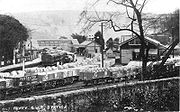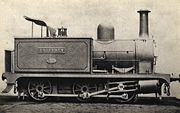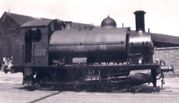
Cornwall Minerals Railway
Encyclopedia

Cornwall
Cornwall is a unitary authority and ceremonial county of England, within the United Kingdom. It is bordered to the north and west by the Celtic Sea, to the south by the English Channel, and to the east by the county of Devon, over the River Tamar. Cornwall has a population of , and covers an area of...
, United Kingdom
United Kingdom
The United Kingdom of Great Britain and Northern IrelandIn the United Kingdom and Dependencies, other languages have been officially recognised as legitimate autochthonous languages under the European Charter for Regional or Minority Languages...
. Based at St Blazey
St Blazey
St Blazey is a small town in Cornwall, United Kingdom.St Blaise is the civil parish in which St Blazey is situated; the name St Blaise is also used by the town council.St Blazey is situated east of St Austell...
, its network stretched from Fowey
Fowey
Fowey is a small town, civil parish and cargo port at the mouth of the River Fowey in south Cornwall, United Kingdom. According to the 2001 census it had a population of 2,273.-Early history:...
to Newquay
Newquay
Newquay is a town, civil parish, seaside resort and fishing port in Cornwall, England. It is situated on the North Atlantic coast of Cornwall approximately west of Bodmin and north of Truro....
and lasted as an independent company from 1874 to 1896, after which it became a part of the Great Western Railway
Great Western Railway
The Great Western Railway was a British railway company that linked London with the south-west and west of England and most of Wales. It was founded in 1833, received its enabling Act of Parliament in 1835 and ran its first trains in 1838...
.
Authorisation
The Cornwall Minerals Railway was authorised by Act of ParliamentAct of Parliament
An Act of Parliament is a statute enacted as primary legislation by a national or sub-national parliament. In the Republic of Ireland the term Act of the Oireachtas is used, and in the United States the term Act of Congress is used.In Commonwealth countries, the term is used both in a narrow...
on 21 July 1873 and opened on 1 June 1874. The act allowed the CMR to take over and replace several earlier railways and tramways:
- The Par and Bugle lines of the Treffry TramwaysTreffry TramwaysThe Treffry Tramways were a disjoint network of horse worked mineral tramways in Cornwall in the United Kingdom. They were named after the man principally responsible for their construction, Joseph Treffry , a local land owner and entrepreneur. At their maximum extent, the Treffry Tramways...
, construction started c.1841, completed from Pontsmill to BugleBugle, CornwallBugle is a village in central Cornwall, United Kingdom. It is in the parish of Treverbyn and is situated about five miles north of St Austell on the A391 road....
in 1847, extended to Par Harbour alongside the route of the Par Canal in 1855 and worked by horse power. - The Newquay lines of the Treffry TramwaysTreffry TramwaysThe Treffry Tramways were a disjoint network of horse worked mineral tramways in Cornwall in the United Kingdom. They were named after the man principally responsible for their construction, Joseph Treffry , a local land owner and entrepreneur. At their maximum extent, the Treffry Tramways...
, also known as the Newquay Railway, authorised by Act of Parliament in 1844, completed in 1849 from Newquay Harbour to both HendraHendraHendra may refer to:People* Hendra Aprida Gunawan , male badminton player* Hendra Setiawan , badminton player* Imay Hendra, badminton player* Tony Hendra , British actor and authorOther* Hendra, Cornwall...
and Newlyn East and worked by horse power. - The Newquay and Cornwall Junction RailwayNewquay and Cornwall Junction RailwayThe Newquay and Cornwall Junction Railway was a broad gauge railway intended to link the Cornwall Railway with the horse-worked Newquay Railway. It opened a short section to Nanpean in 1869, the remainder being built by the Cornwall Minerals Railway who took over the company in 1874...
(NCJR), a broad gaugeBroad gaugeBroad-gauge railways use a track gauge greater than the standard gauge of .- List :For list see: List of broad gauges, by gauge and country- History :...
railway opened on 1 July 1869.
New construction
New connecting lines were opened from the terminus of the Treffry Tramways at Bugle to St Dennis Junction, on the Newquay Railway line to Hendra, and from Hendra to the terminus of the NCJR at NanpeanNanpean
Nanpean is a village in the civil parish of St Stephen-in-Brannel in Cornwall, United Kingdom. It is situated on the B3279 road approximately four miles northwest of St Austell in the heart of 'clay country', the china clay quarrying area of mid-Cornwall.Nanpean church was built in 1879...
. The existing lines of the tramways were relaid to accommodate locomotive haulage, and new bypass sections built to avoid the Carmears Incline and Treffry Viaduct
Treffry Viaduct
The Treffry Viaduct is a historic dual-purpose railway viaduct and aqueduct, located close to the village of Luxulyan, Cornwall, England in the United Kingdom...
, and the low-profile Toldish tunnel.
In addition new branches were built:
- Par to Fowey
- Bugle to Carbis Wharf
- St Dennis to Melangoose Mill.
- Newlyn East to Treamble and Gravel Hill Mine
Traffic and extensions
The heavy iron ore traffic expected from the branches beyond Newquay failed to materialise, leaving the railway with mainly china clayKaolinite
Kaolinite is a clay mineral, part of the group of industrial minerals, with the chemical composition Al2Si2O54. It is a layered silicate mineral, with one tetrahedral sheet linked through oxygen atoms to one octahedral sheet of alumina octahedra...
traffic from around St Dennis and Bugle. A passenger service was instigated from Fowey railway station
Fowey railway station
The railway from Fowey to Newquay was opened by the Cornwall Minerals Railway on 1 June 1874. Fowey railway station was opened on 20 June 1876 when a passenger service was introduced, the next station being at Par....
to Newquay railway station
Newquay railway station
Newquay railway station is the terminus of the Atlantic Coast Line that runs from Par railway station. It is operated by First Great Western and is situated close to the town centre and beaches in Newquay, Cornwall, England, UK.-History:...
on 20 July 1876. The following year, on 1 October 1877, the Great Western Railway took over the operation of the railway and on 1 January 1879 a short line was opened linking the CMR St Blazey railway station
St Blazey railway station
A passenger station was opened at Par on 20 June 1876 when the Cornwall Minerals Railway started a passenger service from Fowey to Newquay. It was adjacent to the railway's workshops...
with the GWR Par railway station
Par railway station
Par Station is a railway station serving the village and port of Par, Cornwall, England in the United Kingdom. It is the junction for the Atlantic Coast Line to Newquay. The station is operated by First Great Western, and served by trains operated by both First Great Western and...
. No through trains were able to run beyond Par until 23 May 1892 when the Great Western main line – and the Newquay and Cornwall Junction line – was at last rebuilt for standard gauge trains.
On 2 October 1893 the Cornwall Minerals Railway was extended with the addition of the new Goonbarrow branch to Carbean. This was outside the operating agreement with the Great Western and so was operated by the CMR on their own account.
On 27 June 1893 the Lostwithiel and Fowey Railway
Lostwithiel and Fowey Railway
The Lostwithiel and Fowey Railway opened in 1869 as a broad gauge railway and links the port of Fowey in Cornwall with the Cornish Main Line at Lostwithiel...
was transferred to the Cornwall Minerals Railway. This broad gauge line had opened on 1 June 1869 but closed on 1 January 1880 after the Minerals Railway had drained most of its traffic. A new connection was put in place between the two lines at Carne Point, new piers constructed and the line rebuilt to standard gauge. It reopened on 16 September 1895.
Acquisition and after
The Cornwall Minerals Railway was amalgamatedConsolidation (business)
Consolidation or amalgamation is the act of merging many things into one. In business, it often refers to the mergers and acquisitions of many smaller companies into much larger ones. In the context of financial accounting, consolidation refers to the aggregation of financial statements of a group...
with the Great Western Railway on 1 July 1896. Most of the company's main line route has survived to the current day as the Atlantic Coast Line
Atlantic Coast Line, Cornwall
The Atlantic Coast Line is a community railway line in Cornwall, United Kingdom. The line runs from the English Channel at Par, to the Atlantic Ocean at Newquay.-Route:The Atlantic Coast Line starts from Par station, in the village and port of Par...
between Par and Newquay, and as the Lostwithiel to Fowey freight line. However the route between Par and Fowey closed in 1968, and was converted to be used as a private road for English China Clays to carry china clay from the dries at Par to the deep sea docks at Fowey.
Stations

- BridgesLuxulyan railway stationLuxulyan railway station is located in the parish of Luxulyan in central Cornwall, England. It is one of the stations on the Atlantic Coast Line.-History:...
– renamed Luxulyan 1905 - VictoriaRoche railway stationRoche railway station serves the village of Roche in Cornwall, UK. It is situated on the Atlantic Coast Line.-History:The Cornwall Minerals Railway opened its line from Fowey to Newquay on 1 June 1874. The trains at first carried only goods traffic and a depot was provided at Holywell...
– renamed Roche 1901, as a goods depot it was known as Holywell until 1876 - HalloonSt Columb Road railway stationSt Columb Road railway station, on the Atlantic Coast Line, serves the village of St Columb Road in Cornwall, UK.-History:The first railway here was a horse-worked line from Newquay Harbour to Hendra Crazey...
– renamed St Columb Road 1878
Note that St Dennis Junction was known as Bodmin Road Junction until 1878 and Tolcarne Junction was known as Treloggan Junction on the Newquay Railway, and then as Newquay Junction from 1874 to about 1885.
Locomotives
The Cornwall Mineral Railway built St Blazey workshopsSt Blazey engine shed
St Blazey Engine Shed is located in Par, Cornwall, United Kingdom. The depot operator is DB Schenker. It is named after the adjacent village of St Blazey and has the depot code is BZ.-History:...
to house and maintain its 18 locomotives. A roundhouse
Roundhouse
A roundhouse is a building used by railroads for servicing locomotives. Roundhouses are large, circular or semicircular structures that were traditionally located surrounding or adjacent to turntables...
with nine roads was provided around a turntable
Turntable (railroad)
A railway turntable is a device for turning railroad rolling stock. When steam locomotives were still in wide use, many railroads needed a way to turn the locomotives around for return trips as their controls were often not configured for extended periods of running in reverse and in many...
, each of which could take a pair of locomotives which were designed to be operated as back-to-back pairs.
Numbered 1 to 18, the 0-6-0
0-6-0
Under the Whyte notation for the classification of steam locomotives, 0-6-0 represents the wheel arrangement of no leading wheels, six powered and coupled driving wheels on three axles, and no trailing wheels...
T locomotives were built by Sharp Stewart and Company. Four carried names:
- 1 Treffrey
- 2 Lord Robartes
- 5 Fowey
- 6 Newquay
The name Treffrey was incorrectly spelt, it should have been Treffry after the owner of the Newquay railway and Par Tramway.
In 1876 the locomotives were transferred to the Great Western Railway who took over the operation of the lines. They kept nine locomotives but sold the remaining locomotives to the Lynn and Fakenham Railway (Norfolk
Norfolk
Norfolk is a low-lying county in the East of England. It has borders with Lincolnshire to the west, Cambridgeshire to the west and southwest and Suffolk to the south. Its northern and eastern boundaries are the North Sea coast and to the north-west the county is bordered by The Wash. The county...
), and Colne Valley and Halstead Railway
Colne Valley and Halstead Railway
The Colne Valley and Halstead Railway is a closed railway between Haverhill, Suffolk and Chappel and Wakes Colne, Essex, in England.-History:...
(Essex
Essex
Essex is a ceremonial and non-metropolitan county in the East region of England, and one of the home counties. It is located to the northeast of Greater London. It borders with Cambridgeshire and Suffolk to the north, Hertfordshire to the west, Kent to the South and London to the south west...
) as surplus to requirements. The retained locomotives were numbered 1392 to 1400 and rebuilt as 0-6-0STs, receiving many standardised fittings at the same time. The last one was withdrawn in 1936, but in 1910 five virtually identical locomotives, the GWR 1361 Class
GWR 1361 Class
The 1361 Class were small 0-6-0ST steam locomotives built by the Great Western Railway at their Swindon railway works, England, mainly for shunting in docks and other sidings where track curvature was too tight for large locomotives.-History:...
, had been built to work alongside them.



| CMR | Disposal | Withdrawn |
| 1 | GWR Great Western Railway The Great Western Railway was a British railway company that linked London with the south-west and west of England and most of Wales. It was founded in 1833, received its enabling Act of Parliament in 1835 and ran its first trains in 1838... 1392 |
1906 |
| 2 | GWR 1393 | 1936 |
| 3 | GWR 1394 | 1933 |
| 4 | GWR 1395 | 1934 |
| 5 | GWR 1396 | 1934 |
| 6 | GWR 1397 | 1933 |
| 7 | GWR 1398, to Sharpness Docks 1883 | 1924 |
| 8 | GWR 1399 | 1934 |
| 9 | GWR 1400; GWR 1398 from 1912 | 1936 |
| 10 | CV&HR Colne Valley and Halstead Railway The Colne Valley and Halstead Railway is a closed railway between Haverhill, Suffolk and Chappel and Wakes Colne, Essex, in England.-History:... |
1948 |
| 11 | Lynn&FR | |
| 12 | Lynn&FR | |
| 13 | Lynn&FR | 1898 |
| 14 | Lynn&FR | |
| 15 | Lynn&FR | |
| 16 | Lynn&FR | |
| 17 | Lynn&FR | |
| 18 | Lynn&FR | 1898 |
The Newquay and Cornwall Junction line was worked by broad gauge locomotives acquired from that railway's contractor. The Great Western Railway in 1876 decided not to use these and provided locomotives from their main fleet. A small shed at Burngullow housed the broad gauge locomotives.
An additional 0-6-0ST named Goonbarrow was obtained by the Cornwall Mineral Railway to operate its new branch in 1893. It was built by Peckett and Sons
Peckett and Sons
Peckett and Sons was a locomotive manufacturer at the Atlas Works in St. George, Bristol, England.-Fox, Walker and Company:The company began trading in 1864 at the Atlas Engine Works, St. George, Bristol, as Fox, Walker and Company, building four and six-coupled saddle tank engines for industrial use...
with 3ft 7in (1,092mm) wheels and 14in × 20in (356mm × 508mm) cylinders. It became GWR 1388 in 1896 and was eventually sold to the Cwm Circ Colliery at Llanharan
Llanharan
Llanharan is a small village in the county borough of Rhondda Cynon Taf, Wales. Llanharan thrived during the British industrial revolution, with several tin and coal mines in the location providing employment to the town's residents...
, Wales
Wales
Wales is a country that is part of the United Kingdom and the island of Great Britain, bordered by England to its east and the Atlantic Ocean and Irish Sea to its west. It has a population of three million, and a total area of 20,779 km²...
, 1911.

